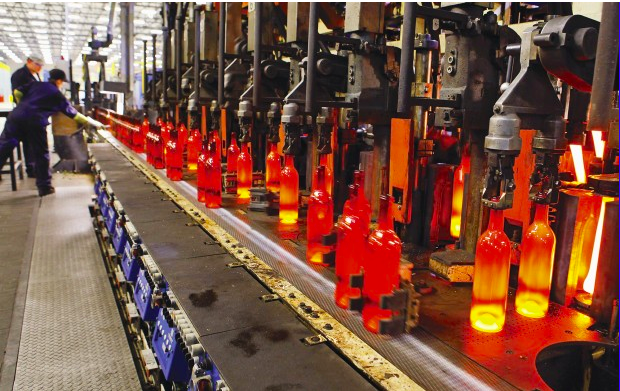

What is used in glass production?
Glass is a special substance, but what is used to make such a material?
Glass is one of the most revolutionary items to be produced by man. If we look around you now, we can guarantee that at least a handful of items in your room are using the material in one way or another. Your windows, smartphones, tablets, music players, TVs, fridges and more all use glass in one way or another, whether it’s protecting you from the rays of the sun and the harsh weather or if it’s keeping your food items cool, glass is a truly amazing thing. For something so amazing, just how is it made? We’re going to look into how glass is produced, and more, in our latest blog.
The Ingredients of Glass
Most glass is made from a mixture of substances, with a large amount of silica being used to make the material. This is then combined with small amounts of alkalies, which is most commonly soda (sodium bicarbonate), which allows the substance to have a lower melting point, with added limestone to help stabilise the mixture, therefore making the glass stronger and way more water-resistant. These elements are found in our nature, so they’re widespread throughout the world.
The Glass-making Process
These three items (silica, soda and limestone) are all fused together at an extremely high temperature, with the heat allowing them to combine. Through this process, other substances can be added, which will allow the properties of the glass to be altered in a number of ways, including its colour, it’s level of reflectivity, how sparkling the glass appears and even how well it acts as an insulator to cold and heat. Old, broken glass is often added in during this process, allowing a recycled element to be used during production. Adding broken glass to the mixture from previous manufacturing is called ‘cullet’.
Pressed Glass: A Widespread Use
Pressed glass is one of the most widespread uses of glass in the modern day. It was the first version of glass that was manufactured on a large scale during the 1920s, as this was the time in which the glass-pressing machine was first invented. The machine would take the molten glass from a furnace and divide it up into smaller sections. A plunger would then press the glass down into a mould and after only a few seconds it would be ready.
Types of Glass and Their Properties
Glass is often categorised by its composition. The most common glass is ‘soda glass’, the combination of the three elements silica, soda and limestone. Though it’s the cheapest type of glass to produce, it coincidentally has the least resistance to high temperatures or even sudden changes in temperature.
For better levels of resistance to temperature changes, the most expensive versions of glass are used, like borosilicate glass for example. A minimum of 5% boric oxide is used, and this type of glass is used to make light bulbs, car headlights, bakeware and more.
Coloured Glass and Its Chemicals
As we said previously, coloured glass is made by adding various chemicals into the mix when it is being prepared. Particular chemicals will create different colour effects on the glass, depending on the chemical in question. For example, the amber/brown colour of the glass often used in beer bottles gets its colour from iron sulphide.
Understanding Glass Production Globally
Glass is everywhere, from the windows in our homes to the screens on our phones. It’s a key material that shapes our daily lives. Let’s dive into some interesting facts and figures that show just how important glass production is around the world.
How Much Glass Do We Make?
In 2022, the world made flat glass worth about $283.26 billion. This kind of glass is used in buildings, cars, and solar panels. It’s a big deal because it shows us how much we rely on glass for so many needs.
Who’s Leading the Way?
Saint-Gobain, a company with a long history in making glass, is at the top when it comes to sales. This tells us that the competition is fierce and that companies are always looking for new ways to stand out.
Cars and Glass
The glass used in cars is a big part of the industry, too. By 2027, it’s expected to become even more valuable. This is because cars are using more glass for both looks and safety.
A Closer Look at Different Places
North America: The demand for flat glass used in buildings is expected to grow a lot from 2018 to 2028. This is good news for construction and shows a push towards more energy-efficient buildings.
European Union: Europe is a major player in glass production, making everything from window glass to glass for bottles. The focus here is on making glass in a way that’s better for the planet.
What’s Next for Glass?
Looking ahead, the glass industry is set to grow and evolve. There’s a lot of excitement around recycling glass, saving energy, and creating smart glass that can do new things. These stats not only give us a snapshot of where things stand but also hint at a bright future for glass.
Looking Ahead
In conclusion, glass remains an indispensable and transformative material, playing a crucial role in both everyday life and technological progress. The creation of glass, through the fusion of silica, soda, limestone, and other materials at high temperatures, benefits significantly from the inclusion of recycled glass, enhancing sustainability. With its diverse applications, from pressed to coloured glass, and its varying properties, such as temperature resistance, glass continues to adapt and serve multiple purposes. The global glass industry, as highlighted, is not only vast, with a market value stretching into the billions but also innovative, pushing towards more energy-efficient and environmentally friendly production methods. As we move forward, the importance of glass in our lives remains undiminished, underscoring the need for continued innovation in recycling and repurposing efforts to ensure its sustainable use for generations to com
For more information on our glass products and glass manufacture, feel free to get in touch, and our friendly will be happy to discuss this further.
FAQ’s
What is the production process of glass?
Glass is made by heating a mixture of silica and other materials to a very high temperature and then cooling it quickly. This is done in a furnace. The molten glass is poured into moulds called pots. These moulds determine the shape of the glass object. The glass is then allowed to cool slowly. This makes sure that the glass is strong.
The different colours of glass are made by adding different amounts of metal oxides to the molten glass. For example, copper oxide makes green glass and iron oxide makes brown glass.
The surface of a piece of glass can be decorated by adding small pieces of coloured glass called frit. This is done when the glass is still molten.
The most common type of glass is soda-lime-silica glass. This is made by adding sodium carbonate and lime to the molten silica. Sodium carbonate makes the glass resistant to acids and lime makes it less brittle.
What are the raw materials for glass production?
The raw materials for glass production are usually silicon dioxide, sodium carbonate, and calcium oxide. However, there are many different recipes that can be used to make glass, so the specific ingredients will vary depending on the recipe. The most common ingredients are typically combined in a furnace and heated until they melt and form a glass batch.
Where is glass mostly produced?
The top five countries in 2020 for glass exports are China, Germany, the United States, Hong Kong and France. China is by far the largest producer of glass accounting for 25.1% of the glass exports in the world. Germany in second place only accounts for 9.1%.
Resource Links and Further Reading
The Glass Manufacturing Industry Council (GMIC) – https://www.gmic.org/ GMIC provides resources and information on the latest advancements and sustainability practices in glass manufacturing.
The American Ceramic Society (ACerS) – Glass & Optical Materials Division – https://ceramics.org/divisions/glass-optical-materials. ACerS offers insights into the research and development of glass materials, focusing on innovation and technological progress.
Glass International Magazine – https://www.glass-international.com/ This magazine covers the latest news, trends, and technologies in the global glass industry, including articles on manufacturing and design.
The Society of Glass Technology – https://www.sgt.org/
The Society is dedicated to the study of glass from both a scientific and technological perspective, offering publications and resources for professionals and enthusiasts alike.
World of Glass – http://www.glassglobal.com/
GlassGlobal provides a comprehensive overview of the glass industry worldwide, including market reports, trade data, and directory services for companies and products.
Statista – Glass Industry Statistics & Facts – https://www.statista.com/topics/4108/glass/
Statista offers a wealth of statistics and insights on the glass industry, including market values, production volumes, and future trends.
The European Container Glass Federation (FEVE) – https://feve.org/about-glass/
FEVE provides information on the sustainability and recycling efforts within the European glass container industry, promoting the circular economy.
Glass Technology Services – https://www.glass-ts.com/
A leading provider of analysis, testing, and consultancy services for the glass industry, focusing on quality, performance, and innovation.

